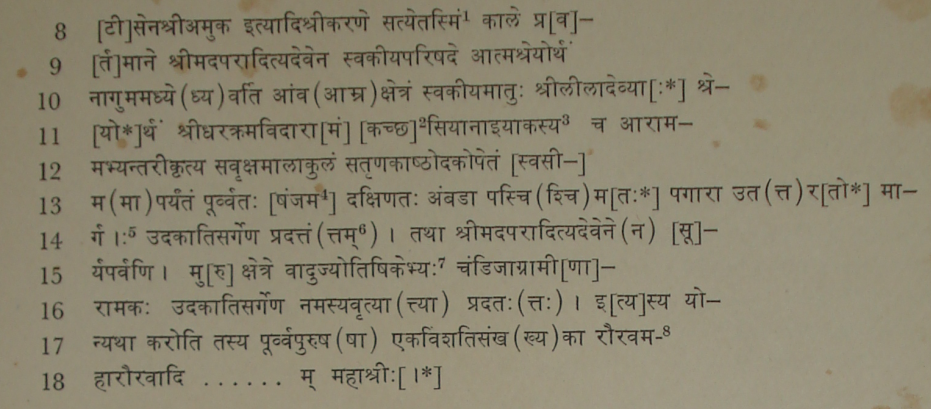|
The Indian Analyst
|
North Indian Inscriptions |
INSCRIPTIONS OF THE SILAHARAS OF NORTH KONKAN
TRANSLATION .. Success ! Hail ! May there be victory and prosperity ! .. In the years one thousand increased by sixty which have passed by the era of the Śaka king− in figures, the Śaka year 19600 –(the month) Māgha, the bright fortnight, 1− on the aforementioned day, −during the beneficial and victories reign of the Mahāmaṇḍalēśvarādhipati, the illustrious Aparādityadēva (I), who is decorated with all royal titles, and while the government consisting of the Mahāmātya, the illustrious Sōḍhala Nāyaka, the Mahāsāndhivigrahika, the illustrious Amuka, the Senior Government Treasury Officer, the Mahāpradhāna, the illustrious Lakshmaṇēyaprabhu, the Junior Treasury Officer, the illustrious Amuka and others, is bearing the burden of the cares of the whole maṇḍala, −at such a time the illustrious Aparādityadēva has donated to his own Parishad, with the pouring out of water, the Āmba (mango) field situated in (the village) Nāguma for his own spiritual welfare, and the orchard belonging to the Kramavid Śrīdhara including the orchard of Kachchasiyā Nāyaka –together with the rows of trees, together with grass, wood and water, and extending to its boundaries−which is bounded on the east by a salty filed, on the south by Ambaḍā, on the west by Pagārā and on the north by a (public) way−for the spiritual welfare of his mother, the illustrious Līlādēvi. .. (Line 14) Again, the illustrious Aparādityadēva has donated, with the pouring out of water and with exemption from taxes, the orchard in the village Chāṁḍijā to the astrologers of (the place) Vādu at the holy place of Muru on the occasion of a solar eclipse.
.. (Line 16) The ancestors, twenty-one in number, of him who would alter this, (will experience pangs ) in the hells of Raurava, Mahāraurava [ and Andhatāmisra for a long time.]
..
May there be [happiness and ] great prosperity !
[1] Read -तस्मिन्.
|
|||||||||||||||||||||||||||||||||||||||||||||||||||||||||||||||||||||||||||||||||||||||||||||||||||||||||||||||||||||
| > |
|
>
|








